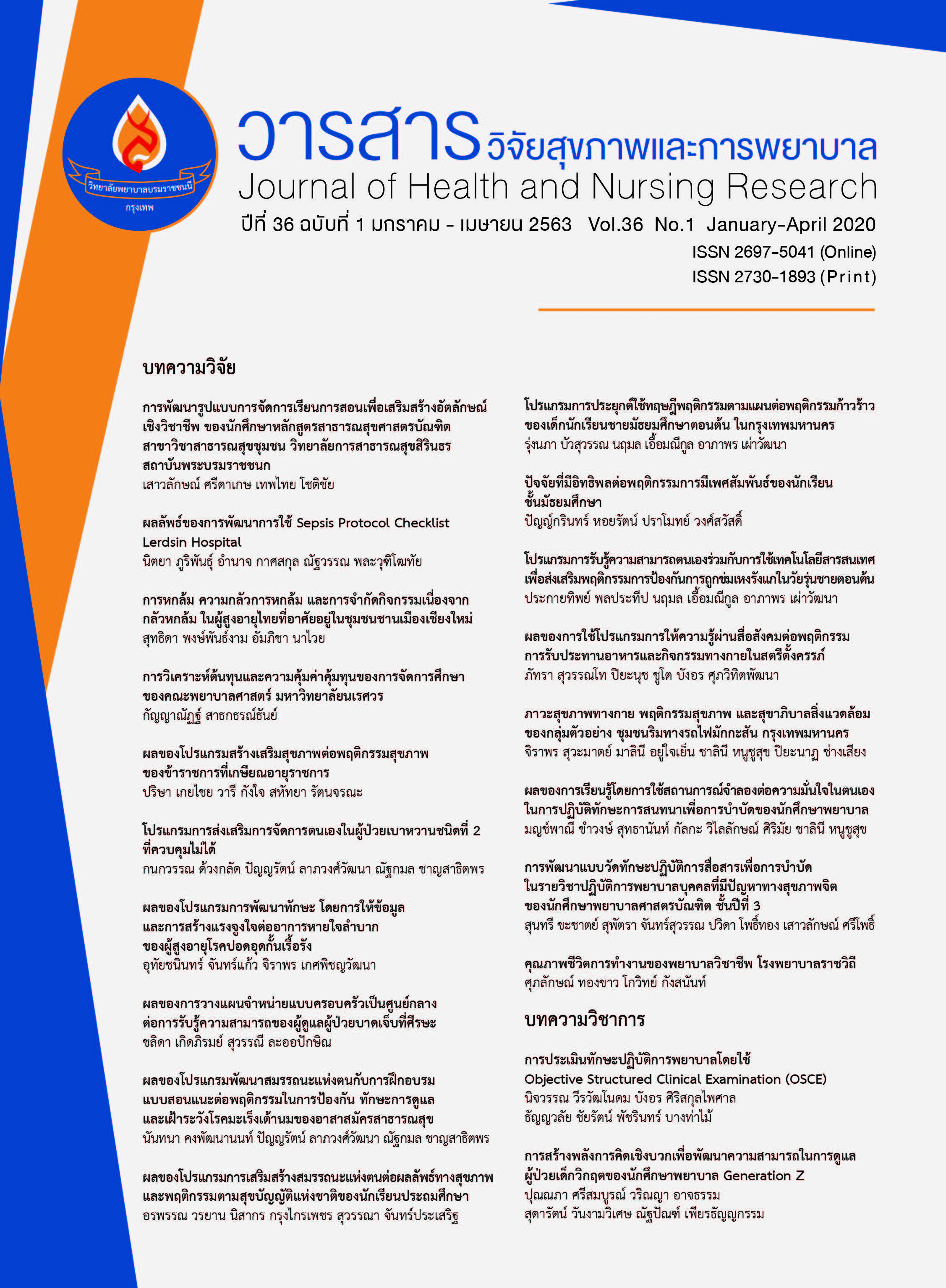ผลของโปรแกรมการพัฒนาทักษะ โดยการให้ข้อมูล และการสร้างแรงจูงใจ ต่ออาการหายใจลำบากของผู้สูงอายุโรคปอดอุดกั้นเรื้อรัง
คำสำคัญ:
อาการหายใจลำบาก, ผู้สูงอายุ, โรคปอดอุดกั้นเรื้อรัง, โปรแกรมการพัฒนาทักษะการให้ข้อมูลการสร้างแรงจูงใจบทคัดย่อ
การวิจัยกึ่งทดลองนี้ มีวัตถุประสงค์เพื่อเปรียบเทียบอาการหายใจลำบากในผู้สูงอายุโรคปอดอุดกั้นเรื้อรัง ก่อนและหลังได้รับโปรแกรมการพัฒนาทักษะ โดยการให้ข้อมูลและการสร้างแรงจูงใจ กลุ่มตัวอย่างได้แก่ ผู้สูงอายุ ที่เป็นโรคปอดอุดกั้นเรื้อรัง อายุ 60 ปีขึ้นไป และเข้ารับการรักษาแผนกคลินิกพิเศษ โรคปอดอุดกั้นเรื้อรัง โรงพยาบาลเชียงรายประชานุเคราะห์ จำนวน 44 คน สุ่มเข้ากลุ่มควบคุม 22 คน และกลุ่มทดลอง 22 คน โดยกลุ่มควบคุมได้รับการพยาบาลตามปกติ ในขณะที่กลุ่มทดลองได้รับโปรแกรมการพัฒนาทักษะ โดยการให้ข้อมูลและการสร้างแรงจูงใจ เป็นระยะเวลา 6 สัปดาห์ เครื่องมือที่ใช้ในการเก็บรวบรวมข้อมูล ได้แก่ แบบประเมินอาการหายใจลำบาก โดยผ่านการตรวจสอบความเหมาะสมและความตรงตามเนื้อหาจากผู้ทรงคุณวุฒิ 5 ท่าน นำมาวิเคราะห์หาค่าสัมประสิทธิ์สหสัมพันธ์แบบง่าย (Correlation coefficient) มีค่า = 0.9 วิเคราะห์ข้อมูลโดยใช้สถิติเชิงพรรณนา และสถิติทดสอบค่าที
ผลการวิจัยสรุปได้ ดังนี้
- ค่าเฉลี่ยระดับอาการหายใจลำบากของผู้สูงอายุโรคปอดอุดกั้นเรื้อรังในกลุ่มทดลองหลังได้รับโปรแกรมฯ น้อยกว่าก่อนเข้าร่วมโปรแกรมฯ อย่างมีนัยสำคัญทางสถิติที่ระดับ .05
- ค่าเฉลี่ยระดับอาการหายใจลำบากของผู้สูงอายุโรคปอดอุดกั้นเรื้อรังในกลุ่มทดลองหลังได้รับโปรแกรมฯไม่มีความแตกต่างจากกลุ่มควบคุมที่ได้รับการพยาบาลตามปกติ
Downloads
เอกสารอ้างอิง
2. Marciniuk DD, Goodridge D, Hernandez P, Rocker, Balter M, Bailey P, et al. Managing dyspnea in patients with advanced chronic obstructive pulmonary disease: a canadian thoracic society clinical practice guideline. Canada Respiratory Journal 2011;18(2):69-78.
3. Promin J. Effects of dyspnea management promotion program on readmission and satisfaction of care among chronic obstructive pulmonary disease patients at Fang Hospital, Chiang Mai Province. Chiangmai: Chiangmai university; 2008. (in Thai).
4. Witheethummasak P. Relationship between symptom cluster and functional performance among chronic obstructive pulmonary disease patients. Chonburi: Burapha University; 2010. (in Thai).
5. Nancy S, Diane K. Chronic critically ill dyspneic patients: mechanisms and clinical measurement. American Association of Clinical Care Nurse. 2001;12(12):220-33.
6. Krainara P, Malathum P, Nathisuwan S, Kawamatawong T. Self-care for medication use in older patients with chronic obstructive pulmonary disease. Rama Nurs 2011;17(2):285-303. (in Thai).
7. Phaephon N. Association between inhalation technique and exacerbation symptoms of patients with COPD at Somdej Prabraromarachineenath Hospital Khonkhen: Khonkhen University; 2011. (in Thai).
8. de Castro MC, de Queiroz, AM, Moreira MAC, Jose RJ, Maria AB, Ruth M, et al. Knowledge about COPD among users of primary health care services. International Journal of COPD 2015;10:1-6.
9. Smith EB. Motivation in pulmonary rehabilitation. London, England: Coventry University; 2008.
10. Runo JR, Ely EW. Treating dyspnea in a patient with advanced chronic obstructive pulmonary disease. West J Med 2001;175:197-201.
11. Osborn CY, Egede LE. Validation of an Information-Motivation-Behavioral Skills model of diabetes self-care (IMB-DSC). Patient Educ Couns. 2010;79(1):49-54.
12. Loyd JJ, Wyatt KM, Creanor S. Behavioural and weight status outcomes from an exploratory trial of the Healthy Lifestyles Programme (HeLP): a novel school-based obesity prevention programme. BMJ Open 2012;2(3).
13. Sitthiamorn J, Suprachutikul A, Rattanalerd S, Rarchaborirak K. Clinical practice guideline. 4thed. Nonthaburi: The Healthcare Accreditation Institute (Public Organization); 2000. (in Thai).
14. Mann SJ. Alternative perspectives on the student experience: alienation and engagement. Studies in Higher Education 2001;26(1):7-19.
15. Kendrick KR, Baxi SC. Smith RM. Usefulness of the modified 0-10 Borg scale in assessing the degree of dyspnea in patients with COPD and asthma. Journal of Emergency Nursing 2000;26(3):216-22.
16. Fisher WA, Fisher JD, Harman J. the information-motivation- behavioral skills model: a general social psychological approach to understanding and promoting health behavior. Malden: Blackwell Publishing, 2003.
17. Polit DF, Beck CT. Essentials of nursing research: appraising evidence for nursing practice. 8th ed. Philadelphia: Lippincott; 2014.
18. Burns N, Grove SK. The practice of nursing research: conduct, critique & utilization. 5th ed. St. Louis: Elsevier Saunders; 2005.
19. Hanujareankul S. Nursing: art of nursing. Bangkok: Faculty of Medicine Ramathibodi Hospital; 2001. (in Thai).
20. Luawnklinhom J. Human psychology and business ethics. Bangkok: Thai Business Administration Technological College; 2004. (in Thai).
21. Phisanbowonsri N. Development of the model for promoting competency in chronic dyspnea self-management for patients with chronic obstructive pulmonary disease: Burapha University; 2007. (in Thai).
22. Friedman DS, Hahn SR, Gelb L, Tan J, Shah SN, Kim EE, et al. Doctor-patient communication, health-related beliefs, and adherence in glaucoma results from the Glaucoma Adherence and Persistency Study. American Academy of Ophthalmology 2008; 115(8):1320-7.
23. Lunnela J, Kaariainen M, Kyngas, H. Adherence of finnish people with glaucoma to treatment plans and connected factors. International Journal of Circumpolar Health 2011; 70(1):79-89.
24. Suwanno J, Suwanno J. Attribute of sociodemographic, illness characteristics, and personal resources on severity of dyspnea in patients with chronic obstructive pulmonary Disease. Thai Journal of Nursing Council 2007;22(2):99-112. (in Thai).
25. Bandura, A. Social foundations of thought and action: social cognitive theory. [internet]. 1986 [cited 2019 Jan 23]. Available from: https://psycnet.apa.org/record/1985-98423-000.
26. O’Donnell DE, Webb AK, & McGuire AM. Older patient with COPD: Benefit of exercise training. Geriatric 1993;48:59-66.
27. Duangpaeng S. Functional status and factors influencing functional status among chronic
obstructive pulmonary disease. Journal of Boromarajonani College of Nursing, Bangkok 2015;31(3):13-24. (in Thai).
ดาวน์โหลด
เผยแพร่แล้ว
รูปแบบการอ้างอิง
ฉบับ
ประเภทบทความ
สัญญาอนุญาต
บทความที่ได้รับการตีพิมพ์ เป็นลิขสิทธิ์ของวารสารวิจัยสุขภาพและการพยาบาล (วิทยาลัยพยาบาลบรมราชชนนี กรุงเทพ) ไม่สามารถนำไปตีพิมพ์ซ้ำในวารสารฉบับอื่น


















